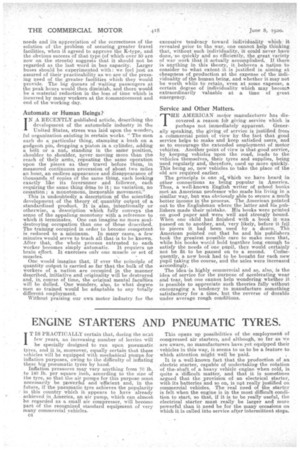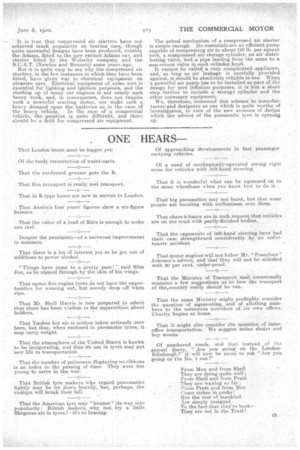ENGINE STARTERS AND PNEUMATIC TYRES.
Page 2

Page 3

If you've noticed an error in this article please click here to report it so we can fix it.
IT IS PRACTICALLY certain that, during the neat few years, an increasing number of lorries will be specially designed to run upon pneumatic tyres, and it ie, moreover, equally certain that these vehicles will be equipped with mechsaical pumps for inflation purposes, owing to the difficulty of inflating these big pneumatic tyres by hand.
Inflation, pressures may vary anything from 70 lb. to 140 lb. per square inch, according to the size of the tyre, so that the air pumps for this purpose must necessarily be powerfa1 and1db...dent and, in the future, if the pneumatic tyre achieves the popularity / in this country which it appears to have already achieved in America, an air pump, which can almost be regarded as •a small air compressor, will become part of the recognized standard equipment of very many commercial vehicles,
a4 This opens up possibilities of the employment of compressed air starters, and although, so far as we are aware, no manufacturers have yet equipped their vehicles in this way, it seems to us to be a feature to which attention might well be paid.
It is a well-known fact that the production of an electric starter, capable of undertaking the rotation of the shaft of a heavy vehicle engine when cold, is quite a 'difficult matter, and that it is sometimes argued that the _provision of an electrical starter, with its batteries and so on, is net really justified on commercial vehicles. The real need of the starter is felt when the engine is in the most difficult condition to start, so that, if it is to be really useful, the electrical starter must really be larger and more powerful than it need be for the many occasions on which it is called into service after intermittent stops. It is true that compressed air starters have not achieved much popularity on touring cars, though quite successful designs have been produced, notably the Adams, fitted to the now extinct Adams car, and starter fitted by the Wolseley company and the S.C.A.T. (Newton and Bennett) some years ago. But it is quite easy to see why the compressed air starters, in the few instances in which they have been fitted, have given way to electrical equipment on pleasure ears. Electrical equipment of some sort is essential for lighting and ignition purposes, and the starting up of many car engines is not nearly, such heavy work, and, in consequence, does not require such a powerful starting motor, nor make such a heavy demand upon the batteries as in the case of the heavy vehicle.. In the case of a commercial vehicle, the position is quite different, and there should be a field for compressed air equipment. The actual mechanism of a compressed air starter is simple enough. Its essentials are an efficient pump capable of compressing air to about 150 lb. per square inch, a compressed air storage cylinder' an air distributing valve, -Fuld a pipe leading from the same to a ,non-return valve in each cylinder head.
It cannot be called a very complicated appliance, and, so long as air -leakage is carefully provided against, it should be absolutely relisble in use. When a powerful air pump has to be installed as part of the design for tyre inflation purposes, it is but a short step further .to include a storag3 cylinder and the other necessary equipment.
We, therefore, commend this scheme to manufaeturers'and designers a.s one which is quite worthy of investigation, in view of the new avenues of design which the advent of the pneumatic tyre is opening up.




























